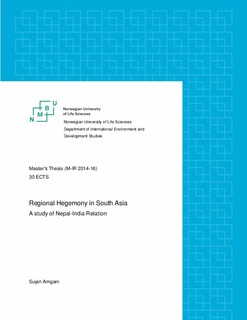| dc.description.abstract | India, by virtue of its geographic location and size, population, economy and other power attributes, in South Asia, is widely perceived to have regional dominance and hegemonic aspirations. It is very well known fact that during the recent few decades India has drastically changed its status from a state with many socioeconomic problems to an emerging power in the world. Since the independence of India in 1947, the Indian leadership has almost consistently shown their interest to assume the leadership and socialize the region according to their interest for a stable and predictable regional environment. Modern Indian aspirations have widely been reflected in political decisions, foreign policy making and the scholarly articles and media coverage in India. Nepal India relation, in the same way, has faced the policy of India that takes South Asia as its sphere of influence or under its security umbrella. Study of Indian hegemonic aspirations in South Asia and especially in case of its relation with Nepal suggests that India is realizing hegemony only to a partial extent.
Struggling to make a common security and economic agenda for the region but troubled by autocratic regimes, economic backwardness and failure of the region to cooperate in all aspects of regional arrangements, India is not being able to have the political and economic environment fully compatible with its policies. In this context, analysis of Nepal India relation in terms of regional hegemony further demands the in-depth study of the regional contexts, structural problems, challenges and opportunities. But in overall, despite its aspirations, Indian hegemonic policies have been challenged by its own internal socio-economic problems, communal strifes, cold relationships with surrounding neighbours and its failure in assuming foreign policies to suit the needs of the small states in its immediate neighbourhood. Yet, India is the country that has the strongest leverage and reputation in international organizations and groupings from United Nations, BRICS, G20, BIMSTEC and it is the only country in its discrete region which has incomparable assets to balance between intraregional and global dynamics of international relations. So this paper argues that India has both the opportunities and challenges on its way of assuming hegemonic leadership in South Asia and in case of Nepal. | nb_NO |

